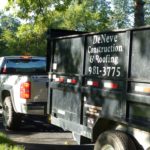Note: Winding Pathways received no discount or special consideration for selecting DeNeve Construction and writing this blog about class 4 rubber shingles. This reflects our personal experience and research.
Most of our Winding Pathways blogs are about managing a yard for beauty, health, and to attract fascinating wildlife. Sometimes we share house tips, especially about energy savings and photovoltaics.
We just learned something new. Our roof’s shingles had been put in about 20 years ago. They were supposed to last longer but were stiff, beginning to curl, and some nails were poking out above the shingles. It was time for a new roof.

The crew were fast, efficient and friendly.
We received three bids from local roofers and hired DeNeve Construction to do the work. Owner Rick DeNeve met us and said, “I suggest you use Class 4 shingles. They are a little more expensive but resist hail and wind and last longer than normal ones. Give your insurance company a call, and you may get a discount if you use Class 4s.”
We did and learned that we’d receive a whopping 26% reduction in home insurance premium cost by using Class 4 instead of less expensive and durable shingles. That’s a savings of about $260 a year in insurance cost.
“Most shingles have a fiberglass base layer. Every spot hit by a large hailstone suffers damage, and this greatly shortens the life of the roof. Class 4 shingles have a rubber base, and hailstones bounce off without damage,” continued DeNeve.
Life Cycle Cost

Men putting on shingles
Whenever we buy anything for the house, we consider life cycle cost. Simply put, that is the cost of the item based on its average annual cost determined by its expected life. Some examples are the roof, paint, refrigerator, and just about everything else people buy.
In this case, cheap shingles would have saved us about $2,000 on our rather large roof but we could expect to change them within 20 years. Class 4 shingles are likely to last at least 30 years. The upfront cost is a little higher but the long-term cost is lower.
That seems to be a common situation. Anything that’s durable is likely to cost more to buy than a cheap counterpart, but in the long run, it is less expensive and saves money, time and inconvenience of replacing the less expensive product. In addition, durable high-quality items often look and function better than cheapies.
We’re probably not going to be around to ever need to reroof our house, but in coming years we’ll enjoy our insurance discount and a beautiful roof that will resist Iowa’s notorious sleet, hail, and heavy rain.
- The sheathing has no rot.
- Lawn magnet to pick up nails.
- The roof blends well with our landscape.





Thanks for sharing. I love hearing about exciting, positive interactions with local businesses. I had no idea that a rubber roof could be so effective.
You are spot on about long term investment which becomes much less costly because you keep the item for way longer than less
expensive investments.
That’s why I love my new glasses…$400+ but totally worth the cost
because I will have them for many moons.(:
I loved watching the roofers. Wow, a huge magnet to pick up nails.
Can’t ask for anything better than that.